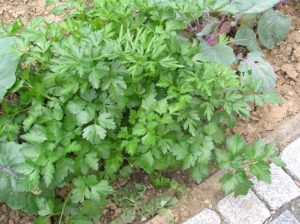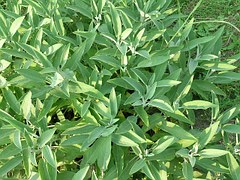Nourishing Encounters: Scarborough Fair Chicken

Scarborough Fair Chicken (recipe below), uses parsley, sage, rosemary, and thyme, the herbs made famous in Simon and Garfunkel’s rendition of the ballad Scarborough Fair. Strong, healthy societies have traditionally been omnivores, eating both plant and animal foods. As opposed to vegetable protein, the protein in chicken is nutritionally complete. Herbs provide important nutrients to help prevent disease and illness. Preparing the chicken is easy and provides a nutrient dense meal.
I never planned on creating a recipe from a song.
One Friday afternoon several years back, when time was at a premium, I needed a quick and easy recipe for my, as of yet, uncooked chicken. I needed ingredients which were at hand to season the chicken. And then it came to me – parsley, sage, rosemary, and thyme – the herb combination made famous by Simon and Garfunkel in their song Scarborough Fair. What inspiration!!
It went over very well, was enjoyed by all and I’ve used this combination many times over the ensuing years. When I have fresh herbs at hand I will use them; however, I often use dried herbs and prepare the herb combination in advance so it will be handy whenever I need it. I do not bother with exact measurements, but use more of the parsley than the other herbs and sage the least.
Of course I thought I was unique, never considering that I wasn’t the only one who used this combination of herbs based on the song. One can find many recipes for Scarborough Fair chicken, a.k.a. Simon and Garfunkel Chicken. I always try to make my meals as nutrient dense as possible. Scarborough Fair chicken fits the bill. Here’s why:
Chicken is an important source of protein and healthy fats.
Dr. Weston Price’s findings, upon which this site is based, found that all healthy societies ate animal products. Those that had few animal products (by circumstance, not choice) were less physically fit.
With regards to endurance and energy levels, Dr. Price traveled around the world in the 1920s and 1930s, investigating native diets. Without exception, he found a strong correlation between diets rich in animal fats, robust health and athletic ability. Special foods for Swiss athletes, for example, included bowls of fresh, raw cream. In Africa, Dr. Price discovered that groups whose diets were rich in fatty meats and fish, and organ meats like liver, consistently carried off the prizes in athletic contests, and that meat-eating tribes always dominated tribes whose diets were largely vegetarian.
It is popular in sports nutrition to recommend “carb loading” for athletes to increase their endurance levels. But recent studies done in New York and South Africa show that the opposite is true: athletes who “carb loaded” had significantly less endurance than those who “fat loaded” before athletic events. [1]
When Dr. Price analyzed the foods used by isolated peoples he found that, in comparison to the American diet of his day, they provided at least four times the water-soluble vitamins, calcium and other minerals, and at least TEN times the fat-soluble vitamins, from animal foods such as butter, fish eggs, shellfish, organ meats, eggs and animal fats—the very cholesterol-rich foods now shunned by the American public as unhealthy. These healthy traditional peoples knew instinctively what scientists of Dr. Price’s day had recently discovered—that these fat-soluble vitamins, vitamins A and D, were vital to health because they acted as catalysts to mineral absorption and protein utilization. Without them, we cannot absorb minerals, no matter how abundant they may be in our food. Dr. Price discovered an additional fat-soluble nutrient, which he labeled Activator X, that is present in fish livers and shellfish, organ meats and butter from cows eating rapidly growing green grass in the spring and fall. All primitive groups had a source of Activator X, now thought to be vitamin K2, in their diets. [2]
Although most literature is quick to note the saturated fat in chicken (as if that were a bad thing), animal fats are generally a combination of various types of fat.
Chicken fat is about 31% saturated, 49% monounsaturated (including moderate amounts of antimicrobial palmitoleic acid) and 20% polyunsaturated, most of which is omega-6 linoleic acid, although the amount of omega-3 can be raised by feeding chickens flax or fish meal, or allowing them to range free and eat insects.[3].
Animal protein provides complete nutrition, not found in plant foods.
A prime advantage of animal proteins is the amino acid content. Animal proteins are nutritionally complete—they contain all the essential amino acids that our bodies cannot manufacture and must obtain from our diet. Most plant sources have incomplete proteins, that is, at least one of the essential amino acids is missing. While different plant sources of proteins can be combined to provide a complete protein, care is required to combine them in a way that ensures all essential amino acids are present in the correct amounts, according to the Center for Disease Control and Prevention. Choose an animal source of protein, and enjoy the freedom of knowing your body is receiving the amino acid balance it needs. [4]
Herbs are an important nutritional component of any meal.
Growing up in the United States in an Ashkenazi family I primarily thought of herbs as garnish and flavor enhancers. I was surprised when I learned years ago that herbs are chock-full of nutrients and important components of a healthy diet. People in countries where the culinary culture involves cooking with lots of herbs are at a distinct health advantage.

Parsley we mistakenly consider more garnish than food. However, it has many important nutrients to support health. Don’t throw it out – eat it!
Parsley is useful as a digestive aid and natural breath freshener, and contains lots of vitamin A, copper, and manganese, plus three times more vitamin C than oranges, and twice the iron than the same amount of spinach. A tea made from parsley is a traditional remedy for colic, indigestion, and intestinal gas, and as an herb helps to purify the blood and fight cancer. Read more
Sage is not to be outdone, with a whole host of nutritional benefits of its own.

Out of the many health benefits of sage, some of the most important include its ability to improve brain function, lower inflammation throughout the body, prevent chronic diseases, boost the strength of the immune system, regulate proper digestion, alleviate skin conditions, increase the health and strength of bones, slow the onset of cognitive disorders, and prevent the onset of diabetes. [5]
Learn more about the health benefits of sage here.

Rosemary grows wild in many areas in Israel. It is more than just a pretty name. Among rosemary’s many benefits:
The herb has been hailed since ancient times for its medicinal properties. Rosemary was traditionally used to help alleviate muscle pain, improve memory, boost the immune and circulatory systems, and promote hair growth. Read more.
If you’ve got the Thyme…
Some of the most interesting health benefits of thyme include its ability to reduce respiratory issues, boost the strength of the immune system,protect against chronic diseases, stimulate blood flow, prevent fungal infections, improve heart health, and relieve stress.[6]

Learn more about the health benefits of thyme here.
Here’s how I prepare Scarborough Fair chicken.
Use a whole chicken, legs, or quarters – your choice. Just make sure to leave on the skin and do not discard the fat. Reserved chicken fat can be used when cooking other dishes as an economical way to add flavor and nutrition. (See Resources below.)
Take the blended herbs and rub them over each piece including underneath the skin in those areas where the skin has pulled away from the meat.
I usually cook the chicken in a large covered frying pan on the stove on medium heat (adjust flame as needed) or in a roasting pan in the oven at about 425°F (218°C).
Place sliced onions, garlic, and carrots into the frying pan or roasting pan and sprinkle them with the PSRT seasoning. Place the chicken on top of the veggies and cook till the chicken is done – juices should run clear and the meat should be white (check near the bone to be sure) and soft. I find that whole chickens take longer to cook than those cut in pieces. Chicken cooked over a medium flame is usually ready more quickly (under an hour) than chicken baked in the oven (about an hour or more). I keep mine covered to keep the oven clean.
You can also enhance it with white wine and other vegetables according to your preferences.
Buy the healthiest chickens and herbs available.
Here you can find companies in Israel selling organic chicken and chicken produced without antibiotics or hormones as well as CSA’s, farms, and other producers selling fresh organic herbs.
Enjoy!
Resources:
Penniless Parenting: Rendering Chicken Fat
The Splendid Table: How to Make Shmaltz
Food Hacks: Why You Should Never Throw Away Chicken Fat
Footnotes:
[1] Myths of vegetarianism
[2] Principles of healthy diets
[3] The Skinny on Fats: Composition
[4] Animal Sources of Protein Advantages/
[5] Health Benefits of Sage
[6] Health Benefits of Thyme
Looks so good and delicious. I really love to try this.
Thanks. Let us know how you enjoyed it.
I can’t wait to try this recipe. It looks delicious. I guess this is Keto friendly as i am on Keto diet.
Tt’s okay for a ketogenic diet. There are no grains in it. Hope you enjoy.